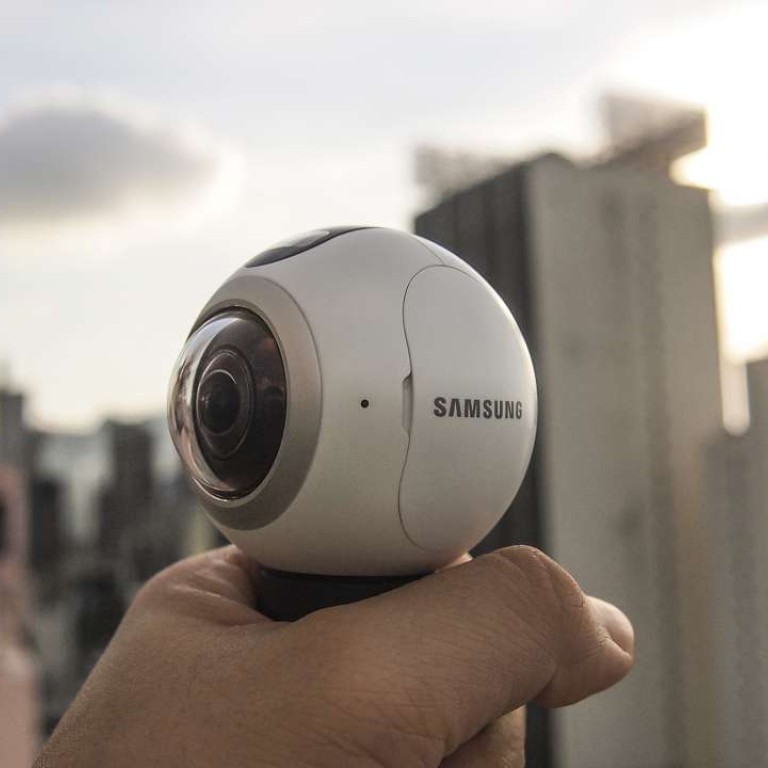
Digital review: Samsung Gear 360 VR camera puts focus on fun and convenience
Short list of compatible smartphones likely to hold back sales of this ‘cute’ piece of kit
Soon after virtual reality headsets such as the Samsung Gear VR and Oculus Rift hit shop shelves, cameras that produce VR content began to appear on the market. Now, 360-degree photography is all the rage. The Samsung Gear 360 is the latest arrival.

The Gear 360 has a striking design. It looks like a futuristic camera drone, if not a cute anime figurine, with its huge lenses.The camera is relatively small, just a little smaller than a tennis ball. The foldable rubber “legs” serve as a mini tripod or a grip. You can interchange this handle with tripods of different sizes on the market.
The camera measures 66.7 x 56.3 x 60.1mm and most of its 153 grams is packed into the top lens module. You may want to slip it into the included pouch or risk scratching the exposed lenses when it is not in use. A flap with rubber seals protects its microSD card slot, USB port and the removeable battery. The rest of the body has a IP53 rating, meaning it can withstand a few quick splashes just fine.
Photo and video quality
The Gear 360 has two lenses – a standard set-up for consumer 360 cameras. Each captures vista – moving or still – up to 180 degrees and they are then stitched together. Objects along the stitch lines become slightly distorted and colours under certain lighting conditions have appeared slightly different also.
It’s not a pleasing effect but isn’t particularly noticeable and such imperfection is compensated by the overall vivid colour reproduction in most resulting photos.
However, in less lit-up areas images become grainy while objects further than a metre away from the camera loses detail and focus.
The Gear 360 is capable of 3840x1920, which is equivalent to 4K (of one 4K standard anyway), and is adequate for casual use. There are plenty of recording modes available and quality settings include 4K, 2k and even 60 frames per second, producing smooth as silk videos.
It’s even capable of correcting tilts because it has an accelerometer and a gyroscope. The biggest issue I encounter with the Gear 360 is that it shuts down randomly, around the 15 minute mark, with no indication of it is off on the highest quality setting.
I was using it independently of the phone (rather than connected, as a remote viewfinder) so I could not have received any error messages. My first suspicion was that it overheated despite being just warm to the touch. At a few steps down from the maximum quality setting (2K, 30 frames per second), I was able to reliably record videos for over an hour.

You can connect your (latest) Samsung phone with the Gear 360 over Wi-fi Direct while hooking up with another Wi-fi and stay online; something that you cannot do with the LG 360 camera.
Recorded videos, for some unknown reason, are split into 1.8GB chunks. That would get you anywhere from eight to 11 minutes of footage, depending on quality settings so you had best have a large Micro SD card handy.
Data transfer happens wirelessly between the camera itself and Samsung’s very short list of compatible smartphones.


All things considered, the Gear 360 makes for a compelling entry level camera for a subset of consumers. At this time, technology doesn’t feasibly put high quality 360 gear into consumers’ hands but instead, is focused on fun and convenience.
One of the biggest barrier to ownership is that you have to use the Gear 360 with a Samsung specified smartphone, that is the S7. If you already own a compatible phone and decide to dip your toes into 360 shooting, then do yourself a favour and grab the Gear VR as well because no other viewing experience can compare to reliving your own footage in VR.
It is unclear what Samsung is aiming for – mass adoption? Proof of concept? Reward for brand loyalty? Assuming the Gear 360 is never made compatible with smartphones from other makers, it simply will not see explosive sales. And yet there is no denying its attractive design and the fun factor in what is so far the best choice for entry level 360 cameras in the market.
Price: HK$2,998
Specifications
Resolution: up to 3840 x 1920 for videos; 7776 x 3888 for stills
Memory type and size: no on-board storage; MicroSD, up to 200gb
Compatibility: Galaxy S6, S6 edge, S6 edge+, Note5, S7, S7 edge
Battery capacity: 1359mAh
Weight:153 grams
